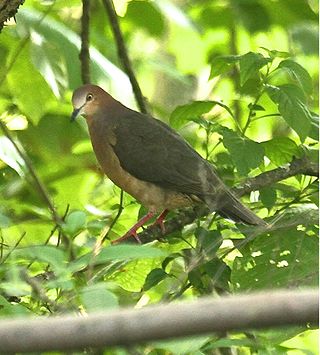
The grey-fronted dove is a large New World tropical dove. It is found on Trinidad and in every mainland South American country except Chile.

The red-crowned woodpecker is a species of bird in the subfamily Picinae of the woodpecker family Picidae. It is found in Costa Rica, Panama, Colombia, Venezuela, Guyana, Suriname, and Tobago.

The bronze-tailed plumeleteer is a species of hummingbird in the "emeralds", tribe Trochilini of subfamily Trochilinae. It is found in Colombia, Costa Rica, Ecuador, Nicaragua, and Panama.

The grey-headed dove (Leptotila plumbeiceps) is a large New World dove. It is found from eastern Mexico to Colombia.

The maroon-chested ground dove is a species of bird in the family Columbidae. It is found in Bolivia, Colombia, Costa Rica, Ecuador, El Salvador, Guatemala, Honduras, Mexico, Panama, Peru, and Venezuela.

The russet-crowned quail-dove is a species of bird in the family Columbidae. It is found in Panama and far northwestern Colombia.

The purplish-backed quail-dove is a species of bird in the family Columbidae. It is found in Costa Rica and Panama.

The lined quail-dove is a species of bird in the family Columbidae. It is found in Colombia, Trinidad and Tobago, and Venezuela.

The sapphire quail-dove is a species of bird in the family Columbidae. It is found in Brazil, Colombia, Ecuador, and Peru.

The olive-backed quail-dove is a species of bird in the family Columbidae. It is found in Colombia, Costa Rica, Ecuador, Nicaragua, and Panama.

The violaceous quail-dove is a species of bird in the family Columbidae. It is found in Argentina, Bolivia, Brazil, Colombia, Costa Rica, Guyana, Nicaragua, Panama, Paraguay, Peru, Suriname, and Venezuela.

The Azuero dove or brown-backed dove is a species of bird in the family Columbidae. It is endemic to Panama.

The Tolima dove is a species of bird in the family Columbidae. It is endemic to Colombia.

The Caribbean dove is a species of bird in the family Columbidae. It is found in Belize, the Cayman Islands, Colombia, Honduras, Jamaica, and Mexico. It has been introduced to the Bahamas.

The ochre-bellied dove or buff-bellied dove is a species of bird in the family Columbidae. It is found in Ecuador and Peru.

The pallid dove is a species of bird in the family Columbidae. It is found in Colombia, Ecuador, and Peru.

The grey-breasted wood wren is a species of bird in the family Troglodytidae. It is found from Mexico to Bolivia.

The dusky-faced tanager is a species of bird in the family Mitrospingidae. It is found in Colombia, Costa Rica, Ecuador, and Panama.

The grey-throated leaftosser is a Near Threatened species of bird in the subfamily Sclerurinae, the leaftossers and miners, of the ovenbird family Furnariidae. It is found in Bolivia, Brazil, Colombia, Costa Rica, Ecuador, Panama, Peru, Trinidad and Tobago, and Venezuela.

The crowned woodnymph or violet-crowned woodnymph is a species of hummingbird in the "emeralds", tribe Trochilini of subfamily Trochilinae. It is found from Belize and Guatemala to northern Peru.























